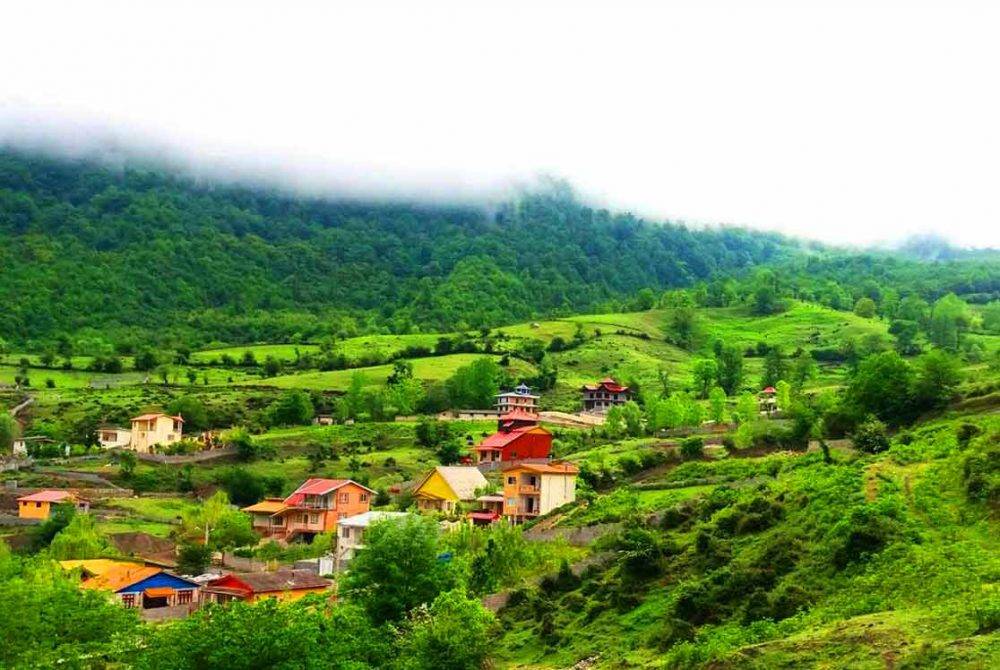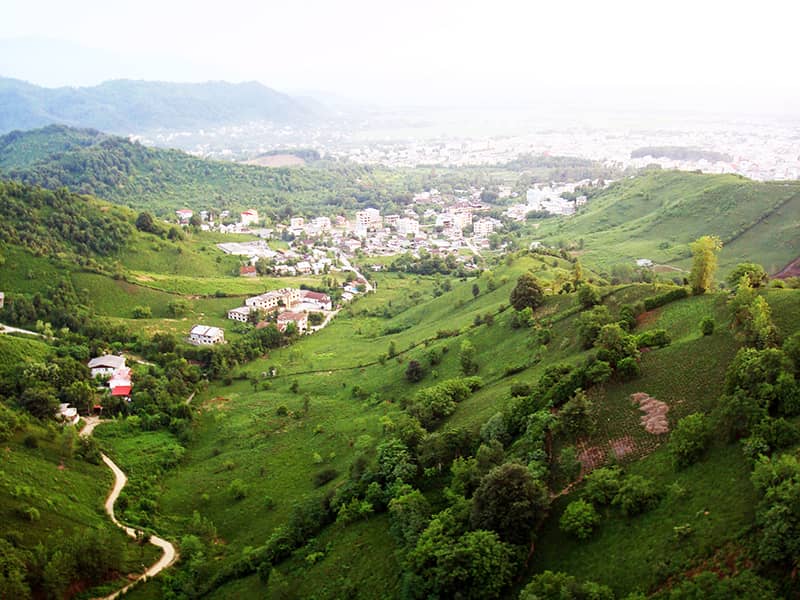Yazd city
Traveling from Amir Chakhmaq Square to the Sacred Fire
Yazd is one of the central provinces of the country, which is known as the first adobe city in the world and the second historical city in the world. This city is known as the “City of Winds”, “Bride of the Desert”, “Dar Al-Ilm” and “City of Bicycles”. In the following, we will discuss some important places in Yazd.
On every trip, the choice of accommodation plays an important role in providing comfort and conveying a good feeling. Booking an eco-tourism accommodation at a very reasonable price and perfect cleanliness, etc. makes this experience so good and unique.
Amir Chakhmaq Square
Amir Chakhmaq Square is one of the most famous tourist places in the city of Yazd, and it is considered one of the historical squares in the country, which shines like a jewel in the ancient context of this city. This square, which contains many attractions from the market to the mosque and the mosque, is an excellent choice for tourism; Especially during the night, which presents before you very beautiful landscapes. The most attractive part of this square is the three-storey building, which attracts the attention of tourists before any other place of attraction. Join us to learn more about this amazing arena.
Amir Chakhmaq Square or Mir Chaghmaq is one of the most prominent tourist places in Yazd. It is registered in the list of national monuments of Iran and consists of various parts such as the market, the hospice, the mosque and the reservoir. The caravanserai known as Shaban located on the northern side of the square and the bathhouse known as “Bafti” on the western side of Amir Chakhmaq are other attractions of this complex. In front of the hospice, there is a large water pool with a fountain and several statues, indicating the role and importance of water and the culture of watering.
This square is the symbol of the city of Yazd and you can visit it at any hour of the day. Especially during the night when the special lighting shows a different effect of this square.


- History of Amir Chakhmaq Square
Prince Chakhmaq Square is a historical and valuable building from the Timurid era in the ninth century AH, built by Prince Jalal al-Din Chakhmaq, one of Shahrukh’s Timurid generals. After reaching the position of governor of Yazd, he, along with his wife, Siti Fatimah, proceeded to build a new congregational mosque in Lower Dohuk, and built a large square in front of it. This mosque and square was later known as Amir Chakhmaq Mosque and Amir Chakhmaq Square. The ruler of Yazd also built other buildings around the square, such as a tank, a bakery, a market, a monastery, an inn, a bathhouse, a cold water well, etc.
Scenes from Amir Chakhmaq Square
a) Pictures of the “Amir Shakhmaq” monastery and hospice

b) Amir Chakhmaq Mosque
The Amir Chakhmaq Mosque does not have a minaret, and according to one tradition, mosques founded by women did not have a minaret, and according to another tradition, they were dedicated to the unity of Shiites and Sunnis; Because Shiite mosques had two minarets and a Sunni mosque had one minaret, and as a result they built it without a minaret so that followers of two sects could use it.
Pictures of Amir Chakhmaq Mosque


c) Water tanks in Amir Shakhmaq Square
The Cistern of Siti Fatimah (Panj Badgiri) is located on the northern side of the square and next to the Haji Qanbar market, which was built by order of Siti Fatimah, the wife of the then ruler of Yazd, for the use of the people.
Since the development and change of the water supply system led to the abandonment of this tank, in 1380 the tank was changed to Zorkhanah (traditional boxing place known as: Zorkhanah) in Yazd, which was done with the efforts of Pahlawan Ali the dramatist.

Part of the reservoirs located in this place have been turned into a museum
The entrance corridor to the city of Fatima, where the museum is located
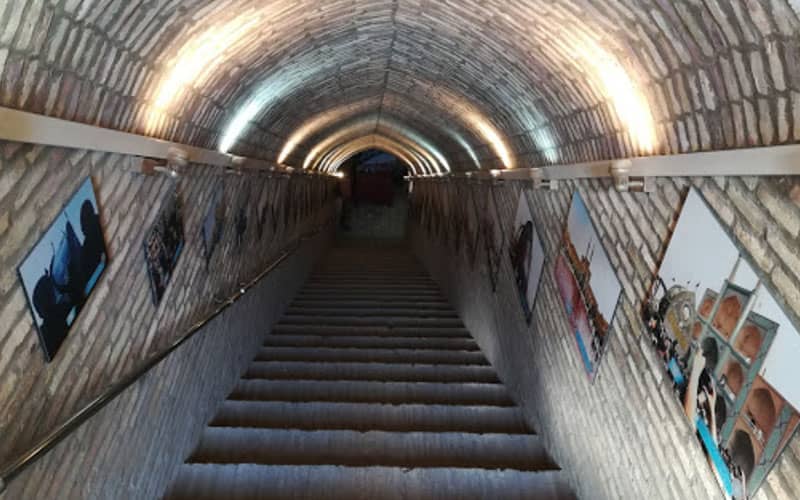

d) the cemetery of “Siti Fatima”
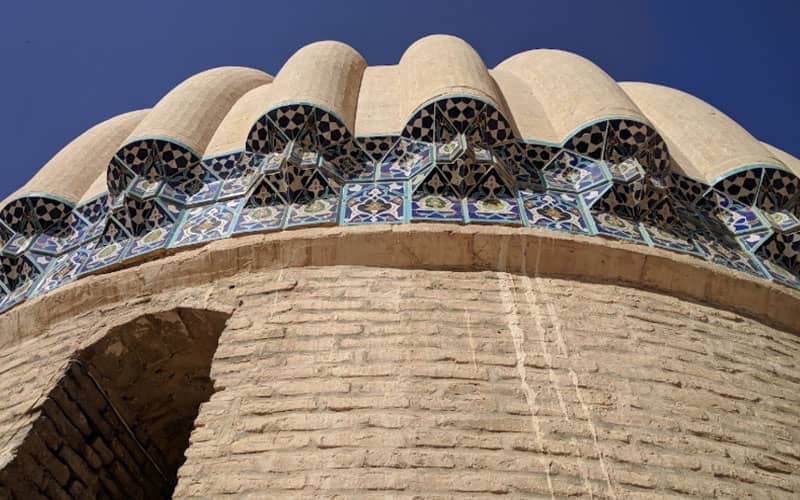
e) Haji Qanbar Market
The said market was built by Nizamuddin Haji Qanbar Jahanshahi, the ruler of Yazd during the Jahanshah Qara Koyunlu period, and for this reason it is known as Haji Qanbar Bazaar.


Here, the places and landmarks of Amir Chakhmaq Square ended, and now we will go to other places in the Iranian city of Yazd.
The Zoroastrian temple "Bahram Yazd" and its sacred fire
The Zoroastrian Fire Temple in Yazd is one of the famous places in Yazd.

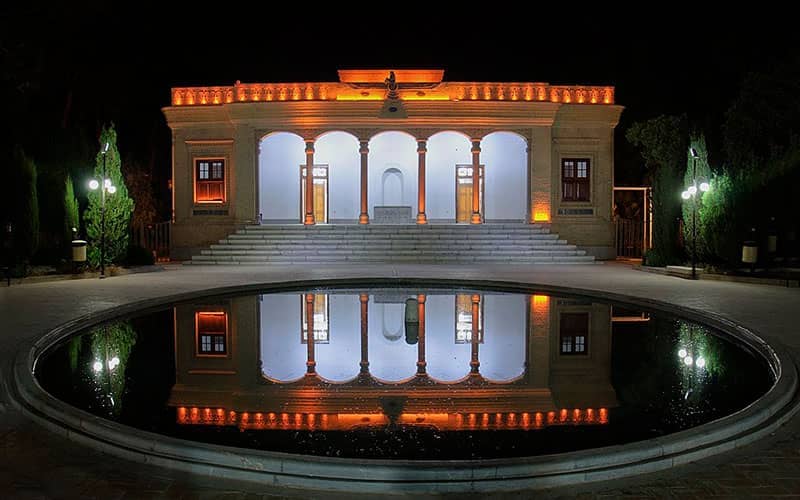
The Bahram Fire Temple in Yazd was included in the list of national monuments of Iran on 22 Shahrfar 1378 AH with registration number 2431. A group of Zoroastrians disagreed on this issue. Because they said that the entry of tourists into this complex would deprive the worshipers of peace and the purity of this place, which occupies a high place in the Zoroastrian religion, would be destroyed. Anyway, due to the high number of tourists visiting this place, a part of it has been reserved for visitors and today it is among the attractions of Yazd Province. The Fire Temple of Yazd is inspiring and beautiful in terms of historical and cultural load, as well as in terms of architecture.
Persian engineers drew the plan for this building and Arbab Jamshid Amanat, one of Amanat’s brothers, took responsibility and supervised its construction. He wrote in his memoirs that he had traveled to India five times to obtain the approval of the Indian Parsi Society, a group of Zoroastrians of Iranian origin, to pay for the construction of the fire temple of Bahram Yazd in the city of Yazd. These journeys were made four times by steamship across the Indian Ocean and once on foot and camel through the sands of Baluchistan, Iran and Pakistan.
A Zoroastrian Persian named Hambay paid for the construction of this fiery temple and chose a piece of land of 6881 square meters for this work, which was given by the Zoroastrian family named Ikhwan Amanat on the death anniversary of their father in the name of “Ardashir Mehriban Rustam Amanat”.
History of the sacred fire of this temple
Inside this temple, there is a bright fire whose light dates back thousands of years i.e. to the time when the Zoroastrian religion was popular in Iran.
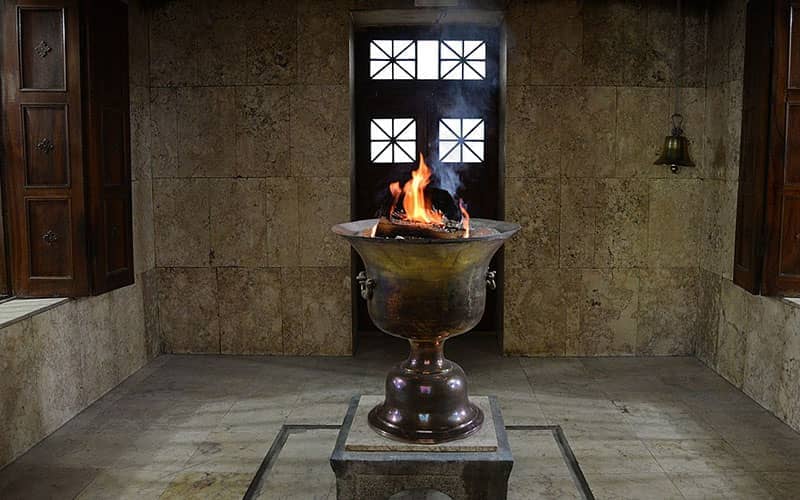
The history of the sacred fire known as the fire of “Varhram” or the fire that was kept in the fire temple in Yazd goes back nearly 1,500 years and the main fire is one of the important fire temples in the Sassanid era, i. Fars Province.Unfortunately, in the 10th century AD, the two guards of this sacred fire were forced to move the fire to the big fire temple in the city due to the enemy’s attack on Yazd.But this fire temple was also destroyed and the Zoroastrians were forced to move their sacred fire again.They went to a cave in Mount Ashkaft in Yazdan (between the region of Aqda and Pars Banu) and protected the fire of Bahram for 30 years from strangers.
In the year 750 AH, a village called Turkabad was built near Ardakan, and most of the Zoroastrians in Yazd, especially Mabadan, moved to that area. The sacred fire was also taken to Turkabad and remained in Turkabad village for 300 years. Unfortunately, the Zoroastrian community in Turkabad separated from each other over time and the holy fire moved again to Sharifabad and returned to Yazd in 1189 AH. The Zoroastrians were forced to keep the sacred fire secretly in a small house in the neighborhood of Yazd (Koi Mabadan).
This issue continued until Reza Shah ordered the construction of the Bahram Yazd Temple during the Pahlavi era (present day 100 years ago). Finally, the Zoroastrians managed to get a place of worship in their dignity. Said fire is placed in a large bronze bowl inside a glass vessel above ground level in a large room and almost out of the sun.
One person is responsible for keeping the fire burning, known as the hirbad. He maintains this fire several times a day by adding a piece of dry wood that is more resistant than other woods such as almond and apricot. Ash from the fuel is of no value and is discharged when needed. Visitors can see this fire from behind the glass. Because human breath should not come into contact with pure fire.

Etiquette of entering the fire temple of Bahram in Yazd
- The fire temple in Yazd is a sacred place and there are rituals for entering it:
- Men and women must clean when entering this place.
- And the sanctity of this place for the Zoroastrians as a mosque for Muslims, and women are not allowed to enter it during certain periods.
- Upon entry, the Zoroastrian men wear a white hat and the women wear a white sash with a light colored dress and take off their shoes.
- No one should go near the sacred fire. Because the soul of a person pollutes it.
Daulatabad Park
Dolatabad Park (Garden) is one of the tourist places in the city of Yazd, which is also considered a world heritage of Iran and is registered as one of the 9 Iranian gardens in the UNESCO World Heritage List. This beautiful garden, which is located in Pamanar district, is considered one of the oldest gardens in the city of Yazd. Stay with Ariana Medical and Medical Tourism in Iran to learn more about this park and its different parts.
During the Qajar era, this garden was connected to the Chahar Minar gate [four minarets], but it was still outside the city. But with the passage of time, the surrounding urban fabric filled it so that the garden was gradually located in the center of the city of Yazd.
History of Daulatabad Garden
Dolatabad Garden in Yazd is one of the great gardens in Iran, which was built in 1160 AH during the Zandiya period. This large garden is one of the foundations and developments of Muhammad Taqi Khan, known as the Great Khan, the head of the Khawanid dynasty in Yazd and the strong man of that era and contemporary with Shahrukh Mirza and Karim Khan Zand. Taqi Khan first created an aqueduct called Daulatabad and then created a garden Daulatabad from the waters of that channel.
Daulatabad Garden area
Daulatabad is one of the most beautiful gardens in Iran, which is built on an area of about 4.6 hectares. At the time of Muhammad Taqi Khan, the garden used to reach a tree-lined avenue from the north side. So that these trees obscured the view from the outside to the garden. That is why this street was also called a thousand trees, it was four to five meters wide and more than 20 kilometers long, and it was heading towards Rahimabad. On the eastern side of the garden, there was an eight-kilometer boulevard, and on the western side of the garden, it was confined to the dry river channel. At that time, the garden was located outside the city walls of Yazd

Architecture of Daulatabad Garden
The tallest Air cacher in the world is located in Daulatabad Park
What makes this garden stand out among the Iranian gardens is Malaqaf, or Tower of the Winds, which is known to be the tallest Malaqaf (Tower of Winds) in the world at more than 33.8 meters. Another advantage of this windlass is that it makes the wind blow in any direction and is easily and quickly directed to the lower part. On the other hand, there is a pond under this barjeel so that by blowing the wind on the water surface of the pond, it creates cool air inside the building. In this building, with the combination of wind and water flowing into the pools within the building, cool air is transported from under the wind screen to the king’s area and lounges. For this reason, this building is also called the summer building.
Picture of the longest wind towers in the word at Iranian city of Yazd
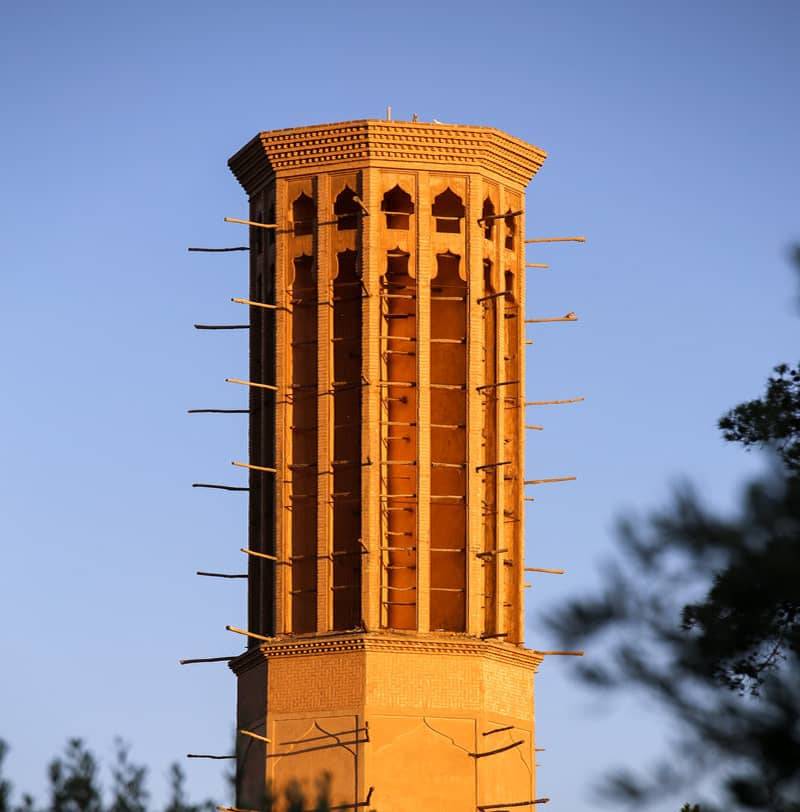
It is 33.8 meters long
The complex of buildings of the Dolatabad Garden arose after the construction and revival of the aqueducts that were formed with the same name and after the surrounding gardens flourished, and buildings including: Sardar Palace, Behesht Ayan Palace, Hall of Mirrors, Tehrani Palace, Heshti Palace or Badgir Palace, Sardar Palace. The green areas of the garden contain fruit trees such as grapes, cypress, and pine, as well as Mohammedan and red flowers appear in the garden. Below we see pictures of all the buildings of this park:

Picture of Heshti Palace

Garden water fountains
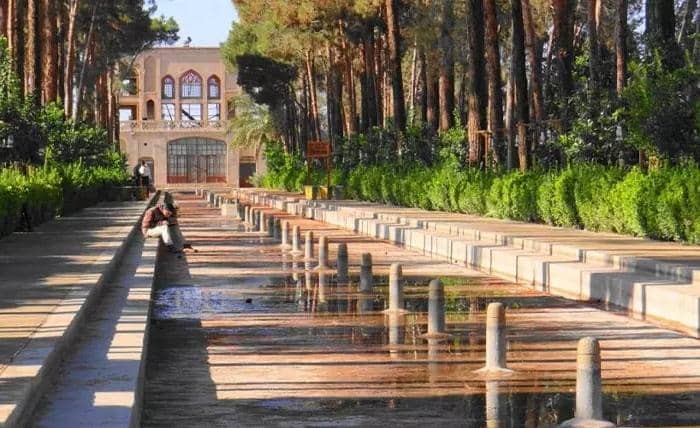
The heritage district of the Iranian city of Yazd
One of the most untouched residential contexts in the history of Iran is the historical and heritage district of Yazd, which covers an area of about 700 hectares. This heritage province is considered one of the best tourist places in Yazd, and it is a balanced mixture of houses and alleys built of mud bricks and cobblestone streets, and in its heart are many historical and heritage monuments. In this heritage county, all facilities for social and individual life are provided. The historical district of Yazd is limited to Kashani Street from the south, Daulat Abad Street from the north, Vahdan neighborhood from the east, and Motahhari Street from the west. There are more than 1,700 adobe buildings in this historic and heritage district.

The city of Yazd was known as “Yazdan” in the legendary history of Iran and the era of the Pashdadis. This city was considered a sacred city from the mythical era of Iran, which was the seat of the gods and the house of worship. During the Sasanian period, the city of Yazd belonged to Yazdgerd and was also known as Yazdgerdi. This city was also known as “Katha” in the historical period
Muddy and narrow alleys with attractive architecture, many restaurants, residences, various hotels, Yazd Jam Mosque, water reservoirs including Shish Badgir [Set Malagaf], the market, and Amir Chakhmaq Square are examples of the tourist attractions of the heritage district of Yazd, which has an amazing attraction for tourists.
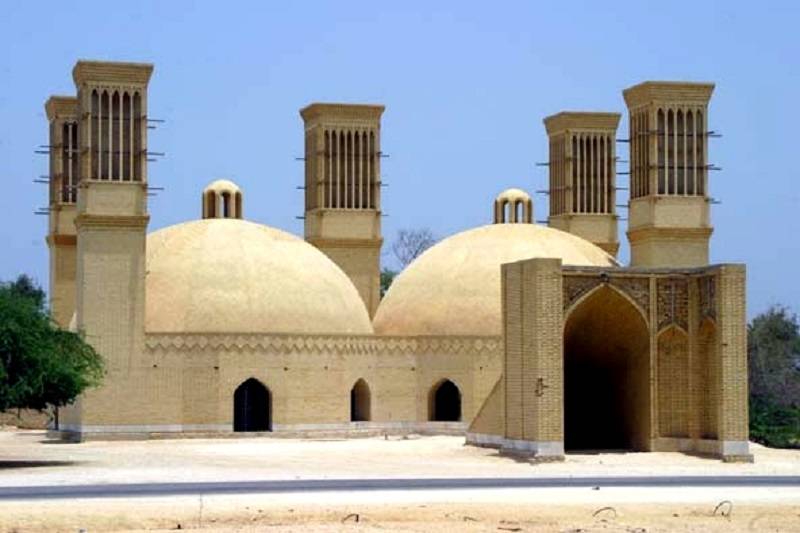
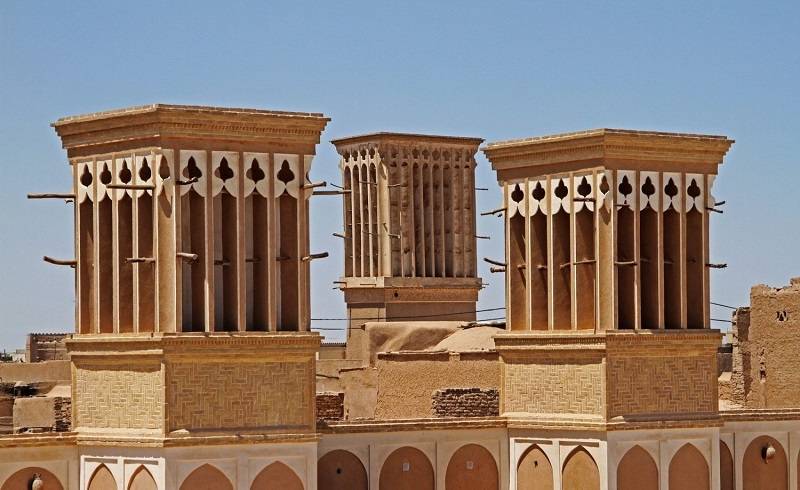
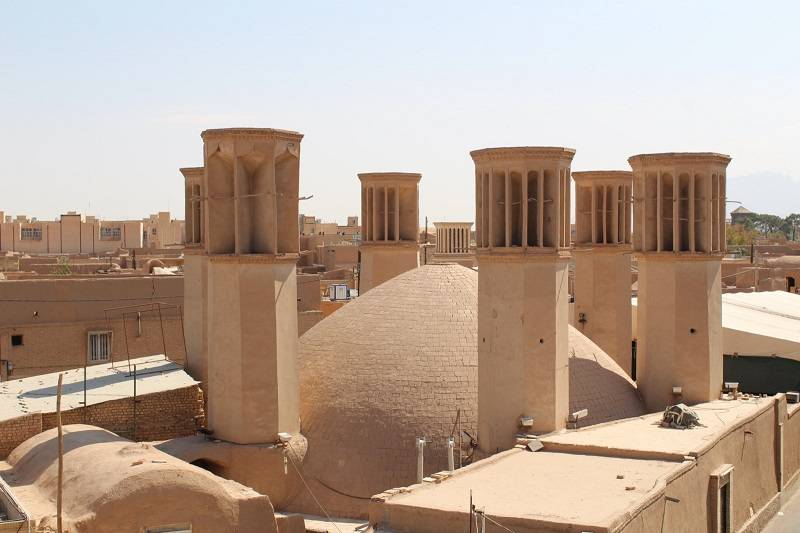
Pictures of cafes and restaurants located in the historical and heritage district of Yazd
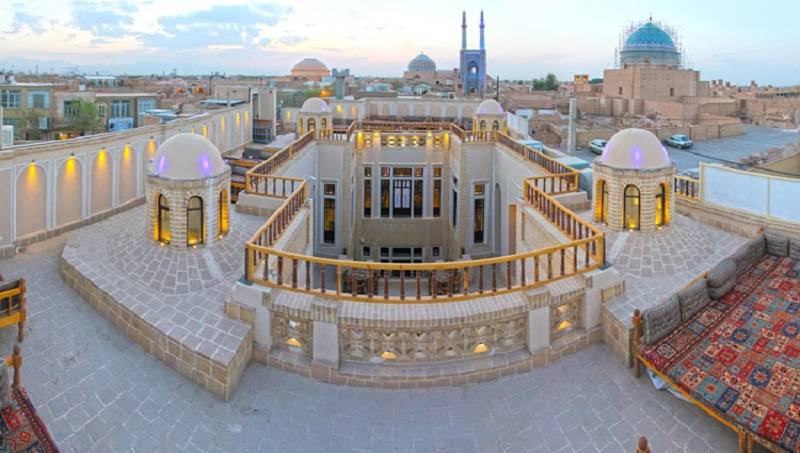

Markar Museum
The Markar Complex is one of the most influential places in the modern history of Yazd and played an important role in educating the residents of Yazd. This historical complex is located near Markar Square and has hosted the Markar Museum since the 1890s.
The Markar Museum, also known as the Museum of Zoroastrian History and Culture, is an ideal place to learn about the history and rituals of Zoroastrianism. Located in the basement of the Markar Collection, with valuable works, this museum deals with religious and traditional clothing, ceremonies and ceremonies, the lifestyle of ancient Zoroastrians, as well as the life of Pashtun Ji Dosabai Markar.
Stay with Ariana Medical Tourism and read more about Markar Museum.
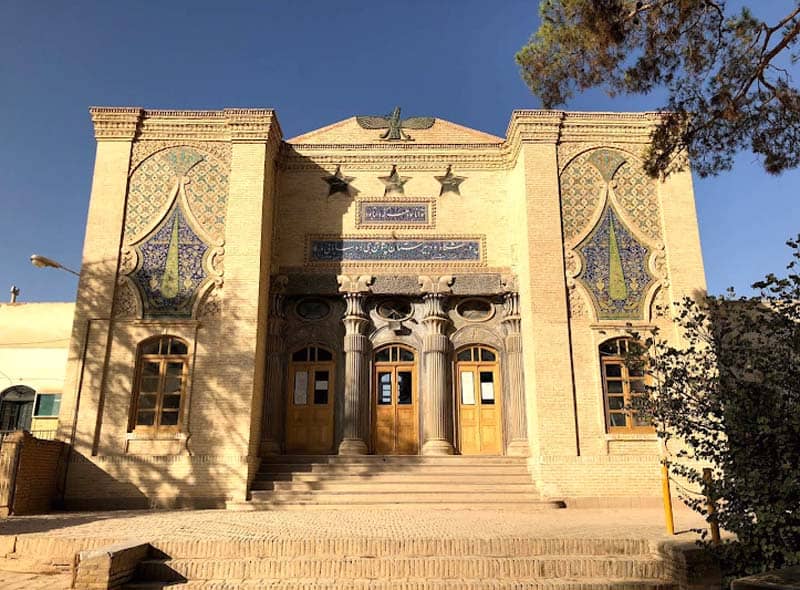
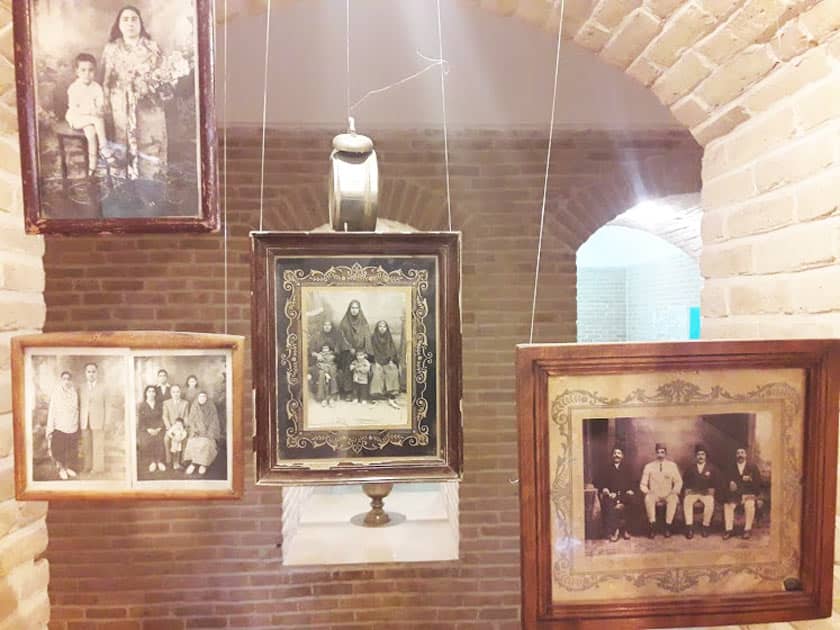

Markar Museum was founded by Mr. Markar. He is a Parsi who was born in India, studied in India and grew rapidly and became wealthy. And because he was one of the Iranian Zoroastrians living in India, he came to Iran and Yazd several times and did many works such as building an orphanage and building a school, high school and hospital in Yazd, which later became the Markar Museum.
A picture of Mr. Markar, founder of the Markar Museum in Iran, in the city of Yazd.
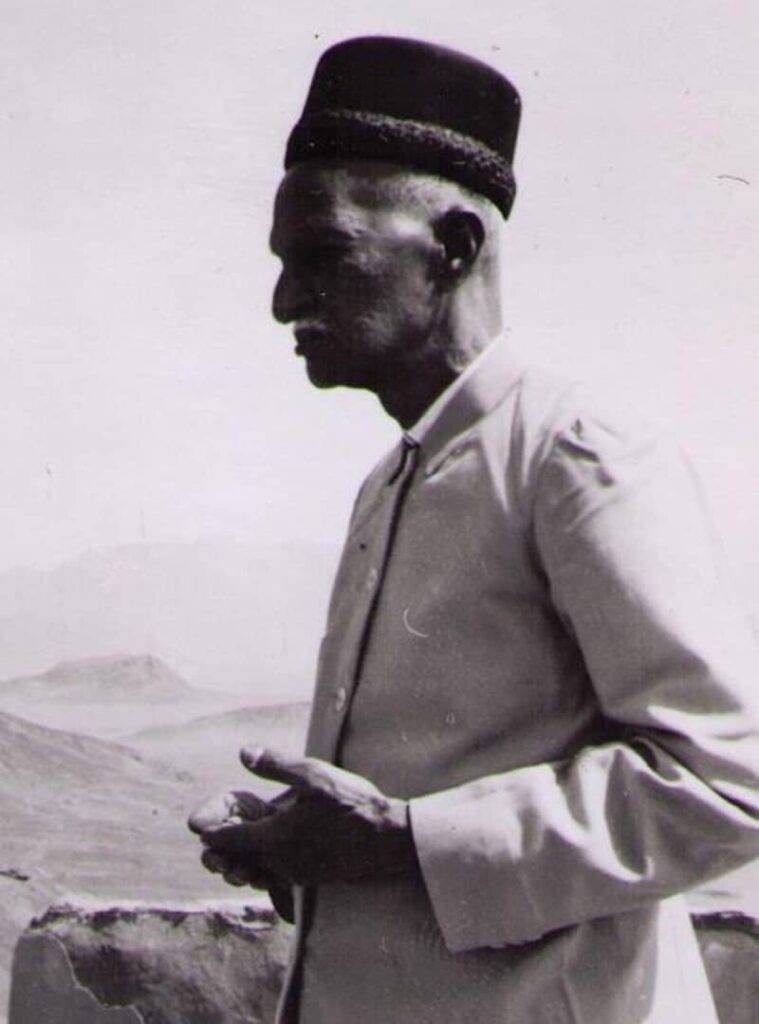
What are the opening hours of the Markar Museum?
Markar Museum is open in the morning from 9:00 to 13:00 and in the evening from 16:00 to 20:00.
Palace of mirrors and light
The Palace of Mirrors Museum is one of the most beautiful historical monuments and places of interest in the city of Yazd, which is considered one of the city’s museums in its unique construction, and its construction dates back to the first Pahlavi period. Apart from having valuables, this building is an example of art and beauty, with an area of 837 sqm, set in a neat garden of 8,174 sqm.
The architecture of the Mirror Palace Museum is a mixture of traditional and European, which consists of different parts such as rooms facing the pool or spring living room, bedroom, and pond. The decoration of the rooms includes plastering, wall painting and mirror work. The doors and windows are wooden and latticed with stained glass. The windows are put together in a simple and colorful way by means of a removable hinge.
Pictures of Miror and lights Palace in Yazd
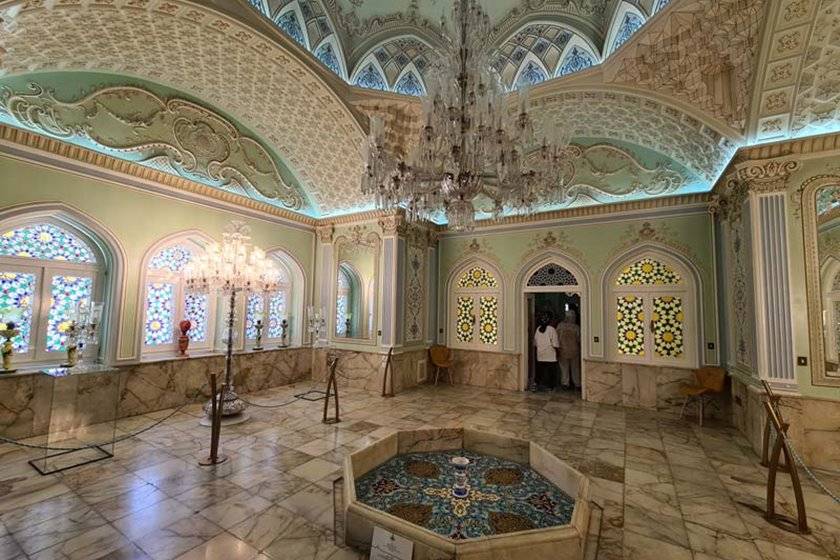
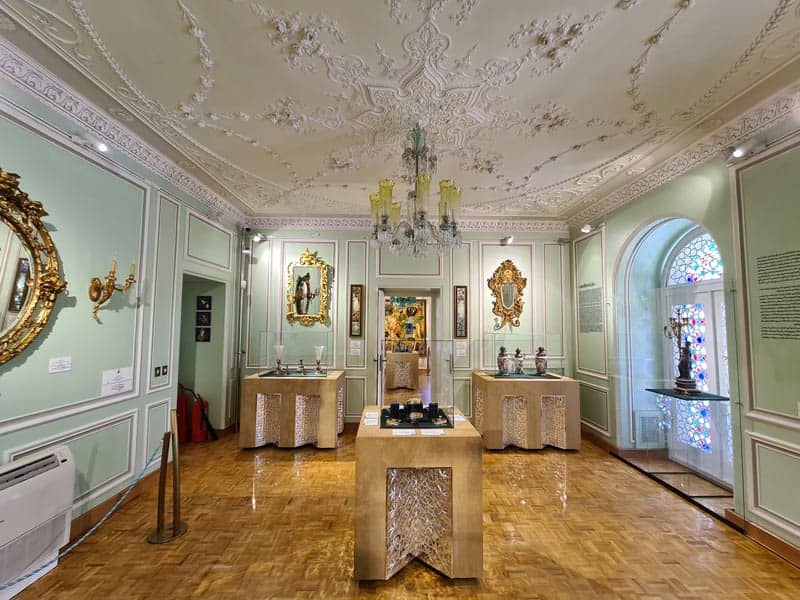

Larry’s House
The Lari House or House of Lariyun in Yazd is a building dating back to the Qajar period. This house was built about 150 years ago and its owner was Haji Muhammad Ibrahim Lari. This palace contains six houses with desert house architecture, which were previously used by the Nematallah Monastery. Larry House was registered nationally in February 1375

Hammam Khan Yazd
Hammam Khan Yazd was built in 1212 AH by order of the then ruler of Yazd. This building was built during the Qajar era, and because most of the city’s sheikhs used it, it came to be known as “Hamm Khan”. In the past, in addition to being used as a bathing place, this bathhouse was also a place to spend time, talk, relieve fatigue, gather friends and solve life problems. But now a new spirit has breathed into the body of the building and by changing its use to a traditional restaurant and café, it attracts many tourists.
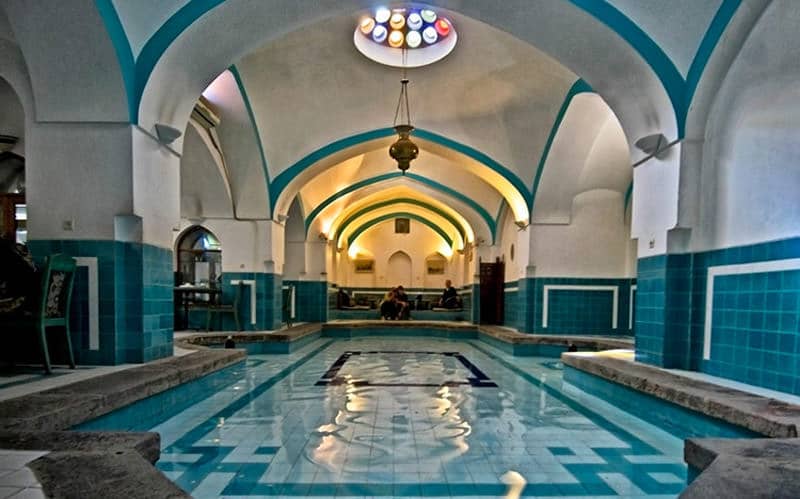
Khamoshan Tower (The Silent Tower)
The Silent Tower is located 15 kilometers southeast of Yazd. This building was the dakhma [silent tower] or Zoroastrian court. The Zoroastrians, according to their religion and tradition, place their dead at the top of these towers to become prey to the vultures. The bones left by the bodies were then poured into the vacant void of the vault. This tower is located on top of a mountain in the Safaiya district of Yazd.
![برج خاموشان[البرج الصامت] بمدينة يزد](https://blog.arianamedicaretour.com/wp-content/uploads/2023/06/برج-صامت.jpg)
![برج خاموشان[البرج الصامت]](https://blog.arianamedicaretour.com/wp-content/uploads/2023/06/برج-خاموش.jpg)
There are many historical and traditional poetry venues in Yazd, which we mention below, and we invite you to join Ariana Tourism Company to enjoy them:
Grand Mosque of Yazd (main and central mosque)
![مسجد جامع یزد[المسجد الرئيسي والمركزي ]](https://blog.arianamedicaretour.com/wp-content/uploads/2023/06/مسجد-جامع-یزدالمسجد-الرئيسي-والمركزي-.jpg)
Zinedine Karwansara
![كاروانسراى زين الدين [أستراحة زين الدين]](https://blog.arianamedicaretour.com/wp-content/uploads/2023/06/كاروانسراى-زين-الدين-أستراحة-زين-الدين.jpg)
Yakhchal Khashti (Freezar Khashti)
![یخچال خشتي[یخجال خشتی]میبد](https://blog.arianamedicaretour.com/wp-content/uploads/2023/06/یخچال-خشتيیخجال-خشتیمیبد.jpg)
![یخچال خشتي[یخجال خشتی]میبد](https://blog.arianamedicaretour.com/wp-content/uploads/2023/06/یخچال-خشتيیخجال-خشتیمیبد1.jpg)

